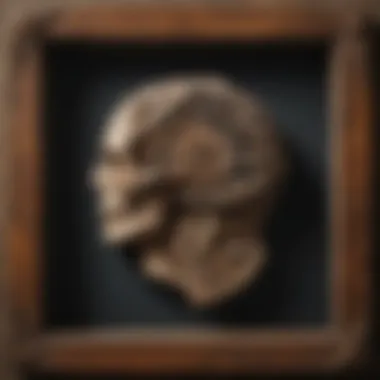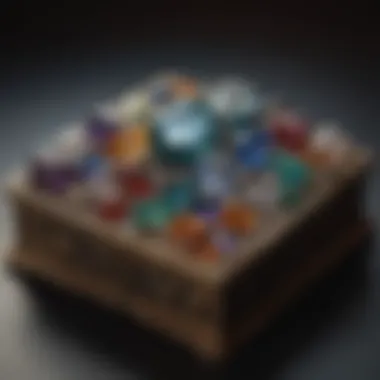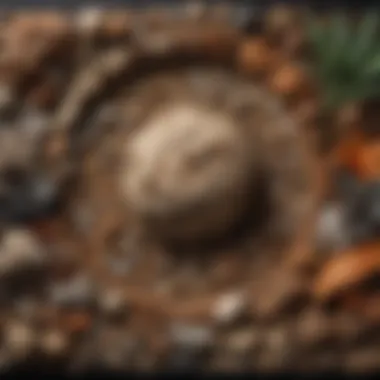Mastering the Art of Crafting a Shadow Box for Rock and Fossil Collectors


Rock and Fossil Identification
Rock and fossil identification is crucial for any collector looking to build an impressive collection. Understanding the types of rocks and fossils is fundamental. Fossils range from petrified wood to intricate ammonites, each with unique characteristics that appeal to different collectors. Rocks encompass a vast array of specimens, from sedimentary to igneous types. Tools such as geology hammers, hand lenses, and identification guides are invaluable for accurate identification.
Collecting Tips and Techniques
Collecting rocks and fossils requires a blend of patience, skill, and knowledge. Best practices involve researching potential collecting sites beforehand. Locating prime sites may involve studying geological maps and consulting with experienced collectors. When on-site, it's essential to handle specimens carefully and use appropriate tools for extraction. Safety is paramount when collecting, as fragile or valuable specimens may be at risk without proper techniques.
Understanding geological formations and processes is key to appreciating rocks and fossils fully. For instance, fossils can provide insights into ancient ecosystems and evolutionary history. Knowing the historical significance of certain rocks and fossils adds depth to a collection. Notable discoveries in the field, like the Burgess Shale fossils, showcase the importance of ongoing research in paleontology.
Preservation and Display
Preserving rocks and fossils is essential to maintain their integrity. Techniques such as cleaning with gentle brushes and using stabilizers for fragile specimens help ensure longevity. Proper storage, whether in acid-free containers or archival boxes, prevents damage from environmental factors. Creative display ideas like shadow boxes or custom shelving allow collectors to showcase their treasures while protecting them from dust and light exposure.
Introduction to Shadow Boxes
Crafting a shadow box is an art form that holds immense importance for rock and fossil collectors. This intricate process allows enthusiasts to showcase their prized geological specimens with elegance and precision. In this comprehensive guide, we will delve into the world of shadow boxes, exploring how they serve as the perfect display option for rock and fossil collections. Understanding the role of shadow boxes is crucial as they play a pivotal role in enhancing the aesthetic appeal of displayed items, creating a captivating visual experience for collectors.
Understanding the Concept of Shadow Boxes
Definition and Purpose of Shadow Boxes
Exploring the definition and purpose of shadow boxes unveils their unique ability to frame and protect collectibles, such as rocks and fossils, while adding depth and dimension to their presentation. This aspect is fundamental in highlighting the individual beauty of each specimen, making them the focal point of attention within the shadow box. The purpose of shadow boxes lies in providing a structured and visually engaging way to showcase collectibles, making them an essential component for rock and fossil collectors aiming to display their treasures with finesse.
Significance in Displaying Collectibles
The significance of shadow boxes in displaying collectibles goes beyond mere presentation; it embodies a method of storytelling through carefully curated arrangements. By utilizing shadow boxes, collectors can create themed displays that illuminate the narrative behind their rock and fossil collections. This approach not only enhances the visual impact of the specimens but also adds a layer of depth and meaning to the overall presentation. The significance lies in the ability of shadow boxes to transform a mere collection into a compelling visual story, captivating viewers and igniting curiosity about the displayed geological wonders.
Benefits of Using Shadow Boxes for Rock and Fossil Collections
Preservation of Specimens
One of the key benefits of using shadow boxes for rock and fossil collections is the preservation they offer to delicate specimens. By encapsulating specimens within a shadow box, collectors can protect them from dust, humidity, and damage, ensuring their longevity and pristine condition. This preservation aspect is crucial for maintaining the integrity of the geological treasures, allowing collectors to enjoy their beauty for years to come.
Enhanced Aesthetic Appeal
Another significant benefit of employing shadow boxes is the enhanced aesthetic appeal they lend to rock and fossil collections. The structured and visually appealing presentation achieved through shadow boxes elevates the overall look of the display, turning a simple collection into a striking focal point. The aesthetic enhancement provided by shadow boxes adds a touch of sophistication and beauty to the displayed specimens, maximizing their visual impact and making them stand out in any setting.
Materials and Tools Required


In the realm of crafting shadow boxes, the selection of materials and tools plays a pivotal role in the quality and execution of the final product. Understanding the importance of choosing the right components is essential for rock and fossil collectors aiming to create visually appealing displays that also ensure the preservation of their precious specimens. This section delves into the intricate details of the materials and tools necessary for crafting a shadow box tailored to showcase rock and fossil collections effectively.
Essential Materials for Crafting a Shadow Box
Crafting a shadow box that exudes sophistication and elegance requires careful consideration of the essential materials that form its foundation.
Frame Selection
One of the primary aspects to focus on when embarking on creating a shadow box is the frame selection. The frame serves as the outer structure that not only secures the contents within but also provides a defining aesthetic element to the overall display. When choosing a frame, considerations such as size, material, and design should align harmoniously with the theme of the rock and fossil collection. Opting for a sturdy frame that complements the size and weight of the specimens is crucial for maintaining the structural integrity of the shadow box over time. Additionally, selecting a frame that offers ease of customization and mounting options can greatly enhance the overall crafting experience for collectors.
Backing Material
The backing material forms the backdrop against which the specimens are arranged, serving as a canvas that enhances the visual impact of the displayed rocks and fossils. Opting for a high-quality backing material not only provides a secure base for mounting but also elevates the aesthetic appeal of the shadow box. Considerations such as color, texture, and durability are essential when choosing the backing material to ensure optimal contrast and support for the specimens. Moreover, selecting a backing material that complements the overall theme or story behind the rock and fossil collection can add a layer of narrative depth to the display.
Mounting Supplies
Mounting supplies are instrumental in securing the specimens within the shadow box, ensuring their safe placement and presentation. From adhesive materials to mounting accessories, having the right tools at your disposal streamlines the assembly process and guarantees a professional finish. Selecting mounting supplies that are specifically designed for rock and fossil displays can help prevent damage to the specimens while also enabling flexibility in arrangement and customization. Prioritizing quality and compatibility when choosing mounting supplies is key to achieving a secure and visually captivating shadow box for rock and fossil collections.
Tools Needed for Assembly
Apart from the materials themselves, the tools used during the assembly process significantly impact the efficiency and precision of crafting a shadow box. Each tool plays a unique role in ensuring seamless construction and integration of the various components that make up the final display.
Scissors
Scissors are indispensable tools that aid in cutting and shaping materials to fit the desired dimensions within the shadow box. Opting for sharp, precise scissors ensures clean edges and accurate sizing, essential for achieving a polished look in the final presentation. Whether trimming backing material or customizing mounting elements, having a reliable pair of scissors improves the overall crafting experience and attention to detail.
Glue or Adhesive
Glue or adhesive compounds are essential for affixing specimens and securing components within the shadow box. The choice of adhesive can vary based on the material of the specimens and the backing surface, with options ranging from water-based adhesives to specialty mounting tapes. Selecting a high-quality adhesive that offers a strong, durable bond without leaving residue is crucial for maintaining the integrity of the display over time. Moreover, considering factors such as drying time and transparency can impact the overall aesthetics and longevity of the mounted specimens.
Mounting Hardware
Mounting hardware consists of tools and fixtures that provide structural support and stability to the shadow box assembly. From clasps and hooks to brackets and screws, choosing the appropriate mounting hardware ensures the secure fastening of the frame and backing materials. Selecting hardware that complements the weight and size of the shadow box components is essential for preventing sagging or misalignment, especially when displaying heavier rock and fossil specimens. Attention to detail in selecting and installing mounting hardware contributes to the overall professional finish and longevity of the shadow box display.
Preparing Your Rock and Fossil Collection
Rock and fossil collectors understand the significance of meticulously preparing their specimens for display. This vital step in the shadow box creation process ensures that each piece is showcased in its best light, preserving its integrity and enhancing its visual appeal. As collectors invest time and effort into curating their collections, organizing and cleaning the specimens becomes a crucial aspect of honoring the geological wonders they have amassed. By meticulously organizing and cleaning these artifacts, collectors can create a visually stunning and cohesive display that not only highlights the beauty of each specimen but also tells a captivating story of the Earth's geological history.
Organizing and Cleaning Specimens


Sorting by Type and Size
Sorting by type and size is essential in presenting a coherent and visually appealing collection. By categorizing specimens based on their characteristics and dimensions, collectors can create a harmonious display that allows viewers to appreciate the diversity within the collection. This method not only showcases the unique features of each specimen but also facilitates a more organized and structured presentation. Sorting by type and size further assists collectors in identifying gaps in their collection and acquiring new specimens to enhance the overall display.
Gentle Cleaning Techniques
Gentle cleaning techniques are imperative to ensure the preservation of rock and fossil specimens. Using delicate cleaning methods helps retain the integrity of the specimens while removing dirt and impurities that may have accumulated over time. Whether it is dusting off surface debris or gently removing stubborn marks, such techniques help maintain the aesthetic appeal of the specimens without causing any damage. By employing gentle cleaning techniques, collectors can ensure that their specimens remain pristine and captivating, ready to be showcased in the shadow box display.
Arranging Specimens for Display
Creating a Layout
Creating a layout involves strategically positioning specimens within the shadow box to achieve visual harmony and narrative flow. By considering factors such as specimen size, color, texture, and shape, collectors can craft a layout that showcases each piece in the best possible way. A well-thought-out layout not only enhances the aesthetic appeal of the display but also creates an engaging visual narrative that draws viewers in. The arrangement of specimens plays a crucial role in capturing the essence of the collection and conveying the collector's passion for geological treasures.
Balancing Visual Elements
Balancing visual elements is key to creating a dynamic and captivating display. By maintaining a sense of equilibrium in terms of color distribution, specimen placement, and empty space within the shadow box, collectors can ensure that the display is visually pleasing and impactful. Balancing visual elements harmonizes the overall composition, guiding the viewer's gaze across the display and highlighting the unique features of each specimen. This attention to detail elevates the display from a mere presentation of rocks and fossils to a work of art that tells a compelling story of natural beauty and geological wonders.
Assembling the Shadow Box
In the realm of crafting shadow boxes specifically curated for rock and fossil collectors, the process of assembling the shadow box stands out as a pivotal stage that demands meticulous attention and precision. Assembling the shadow box is more than just putting together a frame; it is about creating a harmonious environment that not only showcases your geological treasures but also preserves them effectively. This section delves into the intricacies of assembling the shadow box, shedding light on the essential steps and considerations that culminate in the creation of a stunning display piece.
Step-by-Step Construction Process
Securing Backing Material
Securing backing material plays a fundamental role in the structural integrity and visual appeal of the shadow box. The backing material serves as the sturdy foundation on which your specimens will be mounted, ensuring their stability and protection. Opting for high-quality backing material is crucial to fortifying the overall framework of the shadow box. The key characteristic of securing backing material lies in its ability to provide a secure base for attaching specimens while enhancing the overall aesthetic presentation. The unique feature of premium backing materials is their versatility and compatibility with various mounting techniques, offering adaptability to different specimen shapes and sizes. This versatility contributes significantly to the success of the shadow box assembly, providing a seamless canvas for creativity and personalization.
Mounting Specimens
The process of mounting specimens is a delicate art that requires precision and finesse. Each specimen holds a unique story within its geological makeup, and mounting them effectively is paramount to conveying their significance and beauty. Choosing the right mounting technique is essential for securely affixing specimens within the shadow box while accentuating their individuality. Highlighting the key characteristic of mounting specimens involves showcasing them in a visually appealing manner that allows for easy viewing and appreciation. Incorporating secure mounting hardware ensures the specimens are held in place without compromising their integrity. The unique feature of mounting specimens lies in its ability to elevate the display, creating a captivating focal point that draws the viewer's eye to the intricate details of each specimen.
Adding Finishing Touches
Adding finishing touches is the crowning moment of the shadow box assembly process, where attention to detail transforms a collection of specimens into a refined piece of art. The final touches serve to enhance the overall presentation, elevating the visual appeal and cohesiveness of the display. The key characteristic of adding finishing touches lies in its capacity to unify the elements within the shadow box, creating a seamless composition that highlights the beauty of each specimen. Incorporating decorative elements or embellishments contributes to the aesthetic charm of the shadow box, infusing it with personal flair and creativity. The unique feature of finishing touches is the opportunity it provides for customization, allowing collectors to imbue their personality into the display and make it truly their own.
Tips for Achieving a Professional Look
Ensuring Stability


Ensuring stability within the shadow box is imperative for upholding its structural integrity and preserving the showcased specimens. Stability not only prevents accidental displacement of specimens but also shields them from potential damage. The key characteristic of ensuring stability is its role in creating a secure and enduring display that withstands the test of time. By reinforcing the structural components and securing the contents within the shadow box, collectors can enjoy a professional-looking display that exudes sophistication and preservation. The unique feature of stability lies in its ability to instill confidence in the longevity of the shadow box, assuring collectors that their cherished specimens are safeguarded within a stable environment.
Proper Alignment
Proper alignment is key to achieving a polished and professional look within the shadow box display. Ensuring that specimens are aligned harmoniously within the confines of the shadow box enhances visual appeal and balance. Proper alignment highlights the meticulous care taken in curating the display, showcasing a sense of organization and intentionality. The key characteristic of proper alignment is its capacity to create a cohesive visual flow that captivates viewers and emphasizes the unique qualities of each specimen. By meticulously arranging specimens with proper alignment, collectors can elevate the overall presentation of the shadow box, transforming it into a captivating masterpiece that exudes sophistication and precision.
Displaying and Maintaining Your Shadow Box
In the realm of rock and fossil collections, the meticulous craft of shadow boxing extends beyond mere preservation; it's an art form that demands consideration of each detail, including how one showcases and maintains their prized specimens. The topic of Displaying and Maintaining Your Shadow Box within this comprehensive guide holds paramount significance, as it dictates not only the aesthetic allure of the display but also the longevity and integrity of the rocks and fossils housed within.
When contemplating the ideal location for presenting your shadow box masterpiece, a crucial element to ponder is Lighting Considerations. This facet ensures that your geological wonders are illuminated in just the right manner, highlighting their unique features and captivating textures. The interplay between light and shadow can enhance the visual appeal of each rock and fossil, drawing the viewer's gaze to intricate details that might otherwise go unnoticed. Proper lighting can transform a simple display into a mesmerizing exhibit, emphasizing the geological marvels and igniting curiosity.
Protection from External Factors is another critical aspect to consider when establishing the ideal location for your shadow box exhibit. Shielding your collection from potential harm due to environmental elements such as humidity, dust, or direct sunlight is essential for maintaining the pristine condition of your rocks and fossils. By strategically situating your shadow box away from direct sunlight and high-moisture areas, you safeguard your specimens from deterioration and color fading, ensuring they remain vibrant and intact for years to come.
Moving on to Regular Care and Cleaning, embracing proper Dust Removal Techniques is pivotal in upholding the allure and longevity of your display. Dust accumulation is a common foe for any collector, and adopting the right techniques to gently cleanse your rocks and fossils without causing harm is vital. Whether using soft brushes, compressed air, or specialized tools, thorough yet gentle dusting practices can revitalize your geological treasures and maintain their pristine appearance.
Parallel to dust removal, Preventing Damage is a proactive approach to safeguarding your rock and fossil collection. Implementing preventive measures such as protective barriers, temperature control, and routine inspections can mitigate potential risks and ensure the longevity of your specimens. By preemptively addressing factors that could compromise the integrity of your display, you fortify the longevity and integrity of your prized geological treasures.
Inspiration and Further Customization
In the realm of crafting shadow boxes for rock and fossil collections, the section on Inspiration and Further Customization holds a significant role. This segment is essential as it delves into the creative aspects of personalizing one's shadow box, elevating it from a mere display to a unique piece of art that reflects the collector's individual style and interests. By providing inspiration and customization ideas, this section empowers enthusiasts to go beyond the conventional display methods and explore innovative ways to showcase their geological treasures.
Innovative Ideas for Personalizing Your Shadow Box
Thematic Displays
Thematic displays offer a captivating way to infuse a narrative or theme into your shadow box. By curating specimens based on a specific theme such as geological eras, rock types, or fossil categories, collectors can tell a visual story that enhances the overall aesthetic appeal of their display. This approach not only organizes the collection cohesively but also adds a layer of intrigue for viewers, making the shadow box more than just a showcase but a piece of educational art. The thematic approach allows for a structured and visually engaging display, making it a popular choice among collectors aiming to create a more curated and immersive experience. However, the challenge lies in maintaining a cohesive theme throughout the collection without it becoming overwhelming or cluttered, requiring careful curation and design finesse.
Adding Decorative Elements
Integrating decorative elements into a shadow box provides an opportunity to enhance its visual appeal and impart a personalized touch. By including elements such as miniature figurines, geological maps, or relevant artifacts, collectors can elevate the presentation of their specimens and create a multi-dimensional display that sparks curiosity and intrigue. The addition of decorative elements not only enhances the thematic aspects of the shadow box but also allows for creative expression and customization. This approach is beneficial for adding depth and visual interest to the display, making it more dynamic and engaging for viewers. However, the challenge lies in striking the right balance between the specimens and decorative elements to prevent overcrowding and ensure a harmonious composition.
Exploring Advanced Techniques
In the realm of shadow box crafting for rock and fossil collections, delving into advanced techniques opens up a realm of possibilities for creating unique and visually striking displays that stand out. By experimenting with techniques such as layering effects and utilizing mixed media, collectors can add depth, texture, and complexity to their shadow boxes, pushing the boundaries of traditional display methods.
Layering Effects
Layering effects involve strategically arranging specimens at varying depths within the shadow box to create a sense of dimension and visual interest. By placing specimens on different planes or elevations, collectors can generate a dynamic composition that draws the viewer's eye and adds a sense of movement to the display. This technique is beneficial for highlighting key specimens, creating depth perception, and adding a three-dimensional aspect to the shadow box. However, precise arrangement and careful attention to spacing are crucial to avoid a cluttered or chaotic appearance.
Utilizing Mixed Media
Utilizing mixed media in shadow box displays involves incorporating a diverse range of materials beyond the traditional specimens and backdrops. By integrating elements such as miniature sculptures, textured backgrounds, or written descriptions, collectors can enrich the narrative of their display and create a more immersive viewing experience. This approach allows for creative experimentation with different textures, colors, and materials, adding layers of visual interest and storytelling to the shadow box. While utilizing mixed media offers a wealth of creative possibilities, careful consideration must be given to cohesion and harmony to ensure that the various elements complement rather than compete with each other.
These innovative ideas and advanced techniques not only elevate the art of shadow box crafting for rock and fossil collections but also offer enthusiasts a platform for self-expression, creativity, and personalization in showcasing their prized geological specimens.







